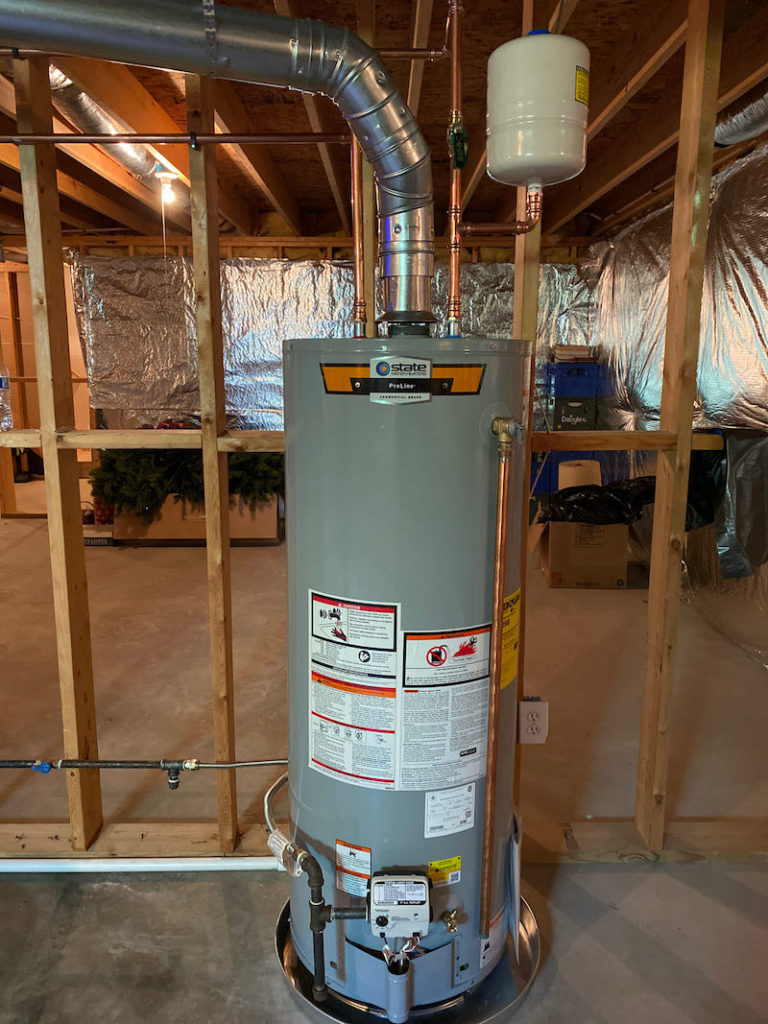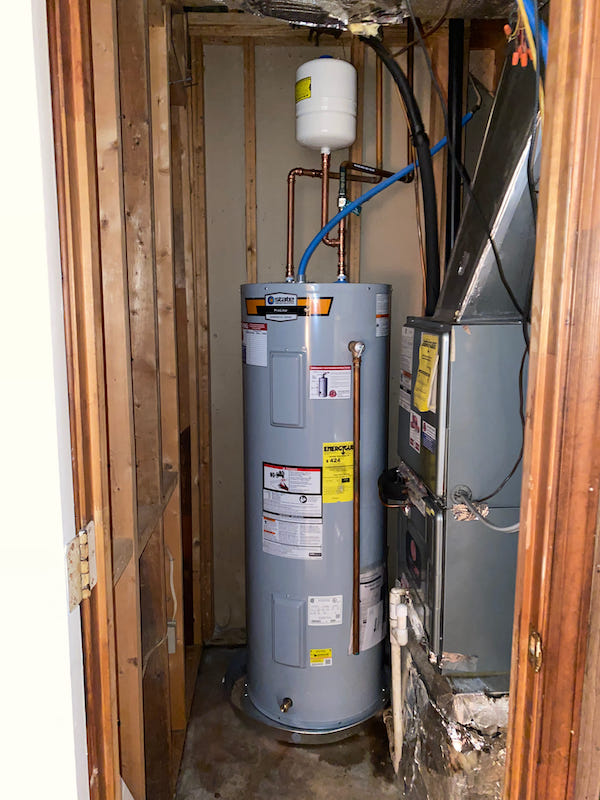Overview
Hot running water is both a need and a luxury.
There is little one can do from cooking to washing up when warm running water is not available, right?
Water heaters work 24/7 to bring us comfort and convenience, and that’s why they are an indispensable part of the home.
It’s only natural for them to break down or malfunction with all the continuous workload.
Today, let us explore the ultimate guide to water heater replacement. Using this guide will ensure that your water heater performs optimally. We want your water warmer and life easier!
So, without any further ado, let’s get started.
Understanding a Water Heater & Its Components
Before we think about water heater replacement, we need to understand how it works.
After all, when you know about the different parts of a water heater, you would be able to replace any faulty component. This will save you from a costly complete heater replacement.

Water Tank
The largest and most important part of your water heater is its tank. This is where the water lives. Cold water reaches the tank through a dip tube.
Once inside the tank, water heats, and it rises upwards. Then it travels through the discharge pipe to the entire house.
Since water tank replacement cost is high. Knowing when to get your water tank fixed could be a lifesaver for you.
Burner & Assembly
As you explore around the water tank, you will find a heat source – mostly gas-based – on the bottom of the water tank.
The heat source – the burner – has its control module on the outside to change the temperature. The module works like a thermostat and gives you the power to change heat settings.
If your water heater is unable to control the temperature automatically, it could be a tell-tale sign that you need a water heater thermostat replacement.
Exhaust Flue
The exhaust flue is a filter that makes sure all the by-product gases of combustion escape out.
It also has an additional function that most people remain unaware of.
It helps the exchange of heat and is essential in improving the time it takes to heat water.
If it’s only the exhaust flue that needs a quick fix, you could save yourself from breaking a bank.
Relief & Drain Valve
Every water heater is fitted with a pressure relief valve and a drain valve that works on a self-correcting mechanism to prevent fatal mishaps.
The pressure relief valve is on the top of the geyser or water heater.
It requires regular maintenance checks to ensure everything is safe.
Regular Maintenance
Maintenance plays an essential role in extending the life of your water heater.
Even if you replace your water heater, regular maintenance will allow you to keep some parts of your old water heater. You may even be able to sell the parts.
A well-maintained water heater system fetches a fair price. This could cover the costs of your new heating system.
Without further ado, let’s dive into how these inexpensive guidelines can keep your new water heater safe. Our goal is to increase its longevity.
Checking The Valves
To check for the valve, lift the valve’s tab and let some water out.
If water continues to flow despite closing the tab, it could mean a need for t&p valve replacement. It could also mean that the dip tube needs replacement.
Anode Rods
Water heating systems have an anode rode attached to them.
Calcium builds on these rods that affect the system’s performance.
Getting new rods for the anode water heater could be a move that saves you a couple of thousand bucks.
Cleaning
You knew we were going to ask you to clean up, didn’t you?
In this line of work, we have seen hundreds of avoidable issues. They could have been solved or would have never occurred if there was regular cleaning.
Once every year, you can drain the water out of the tank and clean it to get rid of any sediments.
Cleaning the tank surely beats hot water tank replacement cost!
Low Duty Usage
Water heating systems work round the clock and for years. That is part of their design.
However, sometimes they can get overworked too.
Preventing a burnout is necessary.
When it’s warm outside, you might want to bring the heating system settings to their lowest. This is especially important when you are away from your house and do not need running hot water.
Prevention Over Cure
Don’t worry.
We are not going to chime in an age-old adage about how prevention is better than cure.
We aren’t that predictable.
Water heating systems are evaluated based on their efficiency. Things that affect efficiency include how much gas is required to heat a specific volume of water. They also rate how quick it is, and what percentage of energy becomes waste.
Efficiency, and thus the longevity of your heating system, can be improved by one simple trick – insulation.
Covering the water heating system, including the pipes, helps conserve heat. It also reduces the digits on your utility bills.
Water Heater Replacement
Let’s assume you did all you had to do, yet your water heater could not outlive your expectations.
Where does one go from here to get hot water that offers a much-needed break when you step into your bathtub?
We have the answer for where to go. Our guide also details how to determine when it is the right time to get a new water heater.

Rusting
Rust is the machine is the equivalent of wrinkles.
Therefore, a little bit of rust on some of the parts is normal.
It shows your water heater’s years of wisdom!
However, rusting that covers the tank can be potentially dangerous.
Often rust gets so bad that it begins to show in the water that you use. Don’t let it get to that point.
Noises
While some noises are treatable and should not cause concerns. Other noises are a call for help; or in your case, a call for hot water tank replacement.
Noises that cannot be fixed stem from issues in the pressure valve or the drip tube.
The only way to rid your home of the sounds is by having a new water heater installed.
Leaks
Leakages that you witness around the tank or the body of the water heating system are signs of wear and tear. These leakages require getting a new system.
On the other hand, leaking pipes are normal.
You can replace them or even fixed with some duct tape.
Failing To Heat Water
What good is a water heating unit when it does not heat water?
It is time to replace it with a water heating system that does its job.
Time For a Goodbye
We get attached to our belongings.
It’s easy to see how difficult it could be to say a final goodbye to our water heaters – ones that kept us warm for so very long.
Water heaters have a lifespan of 8-10 years.
Even if your water heater does not show signs of aging or wear and tear, the recommendation is a replacement. At the very least, it needs a check-up from a professional company.
Professional Help VS DIY
There are two options when it comes to getting a hot water tank replacement:
i- Getting it replaced by a professional company
ii- Getting your hands dirty and Doing It Yourself (DIY)
Let us make the choice simple for you. We want to share insights about when it is good to hire someone else and when it’s wise to hire yourself for the job.
First, you should give your geyser a look yourself.
A little cleaning, dusting, and observation help diagnose the issue and find a solution most of the time.
However, suppose your water heating system is a bigger unit and has a complex system of valves, pipes, and a gas source.
In that case, we recommend getting a professional plumbing and air service company, such as OHA HVAC, Plumbing, Roofing, Chimney & Fireplaces. They will have your water heater replaced promptly and effectively.
With a simple Google search, such as hot water heater replacement near me, you can find several options to consider right in your neighborhood.
So, what are you waiting for?
DIY Method
Assuming you choose to replace your water heating system yourself, let us give you a few tips that will make the entire process seem as easy as turning on a tv.
1. Turn off the water supply
The biggest concern is gushing water coming out of every possible pipe. To prevent wasting countless gallons of water, it is necessary to turn off all water supply connected to your water heater.
2. Drain the water from the heater tank
This is pretty straightforward. You can’t fix the water heater with water inside the tank. Drain it safely without having a mini flood in your house.
3. Close the gas source and electrical supply
Gas is highly flammable. As you are working on replacing your water unit, you can cause an explosion if the gas source is not closed off.
4. Disconnect the water heater vent
Once you have dismantled the water heating system, you can install the new one with these directions:
1) Swap the old water heater with the new one
2) Install the relief valve and other joints
3) Check for anode rods, valve tabs, and exhaust flue
4) Connect the water lines and gas and electric source
Parting Thoughts
DIY water heater replacement can be a daunting task that can cost you time, energy, and even money.
The replacement process coupled with water heater installation cost can drive anyone crazy.
Keep your sanity, opt for professional water heater replacement services, Then, wave goodbye to all your water heater-related worries!










